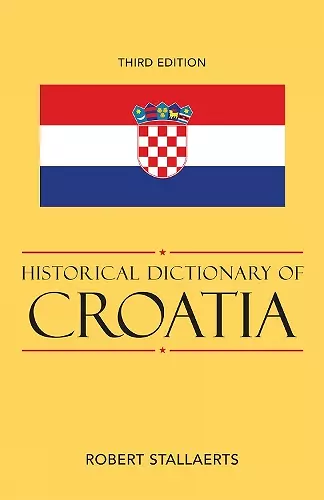Historical Dictionary of Croatia
Format:Hardback
Publisher:Scarecrow Press
Published:22nd Dec '09
Currently unavailable, and unfortunately no date known when it will be back

Croatia, a former republic of Yugoslavia, has been a self-declared independent state since July 25, 1991. To its own people, however, it is a much older country that is finally getting another chance to forge a nation. The Croats trace their roots back many centuries, and the depth of this resurgent nationalism helps explain why Yugoslavia split as it did and where it did. As Croatia and its people try to make a success of their new state, they can take hope in the notable progress that has already been made in regards to its economic restructuring, democratization, and a rapprochement with their neighbors and Europe more broadly. The third edition of the Historical Dictionary of Croatia relates the history of this country through a detailed chronology, an introduction, a bibliography, and cross-referenced dictionary entries on significant persons, places, and events; institutions and organizations; and political, economic, social, cultural, and religious facets.
This new edition contains about 650 entries that cover ethnic groups; historic events; locations (cities, islands, regions, towns); key documents; organizations; and Croats from a range of fields (activists, artists, government officials, journalists, military persons, philosophers) and time periods. Especially noteworthy are the large number of general topics. Examples include Agriculture and fishing, Environment, Foreign policy, Health, Language, and Religion. Author Stallaerts also provides entries that describe Croatia's relations with other countries, for example, United States (relations with). Information appears fairly current. For example, in the entry Economy, Stallaerts describes the effects of the recent financial crisis on the Croatian economy and the Croatian government's efforts to confront the recession. Some entries are very short (e.g., two sentences on the river Cetina). The longest entries are about 8 pages (e.g., Political parties, Yugoslavia). Besides see and see also references, bold type within text indicates separate entries. The length of the concluding bibliography has increased from 80 pages in the previous edition to 90 pages here. Especially useful for novices, a 16-page bibliographic introduction highlights key information s * Booklist, July 2010 *
The entries are informative, easy to understand, and contain very useful see also and boldface type cross-references. This edition is a necessary and worthwhile update to the previous one and would be a valuable addition to any library with research collections in Slavic studies. * American Reference Books Annual, May 2010 *
This new edition contains about 650 entries that cover ethnic groups; historic events; locations (cities, islands, regions, towns); key documents; organizations; and Croats from a range of fields (activists, artists, government officials, journalists, military persons, philosophers) and time periods. Especially noteworthy are the large number of general topics. Examples include Agriculture and fishing, Environment, Foreign policy, Health, Language, and Religion. Author Stallaerts also provides entries that describe Croatia's relations with other countries, for example, United States (relations with). Information appears fairly current. For example, in the entry Economy, Stallaerts describes the effects of the recent financial crisis on the Croatian economy and the Croatian government's efforts to confront the recession. Some entries are very short (e.g., two sentences on the river Cetina). The longest entries are about 8 pages (e.g., Political parties, Yugoslavia). Besides see and see also references, bold type within text indicates separate entries. The length of the concluding bibliography has increased from 80 pages in the previous edition to 90 pages here. Especially useful for novices, a 16-page bibliographic introduction highlights key information sources on Croatia that include many Internet resources. Additional features include a 25-page chronology, a 20-page introductory historical essay, and five maps of fair quality. Although the depth and length of entries remain limited, the scope and currency of the third edition strengthen its role as a ready-reference and introductory research tool on Croatia. A key resource for academic libraries. * Booklist, July 2010 *
ISBN: 9780810867505
Dimensions: 226mm x 150mm x 36mm
Weight: 803g
526 pages
Third Edition